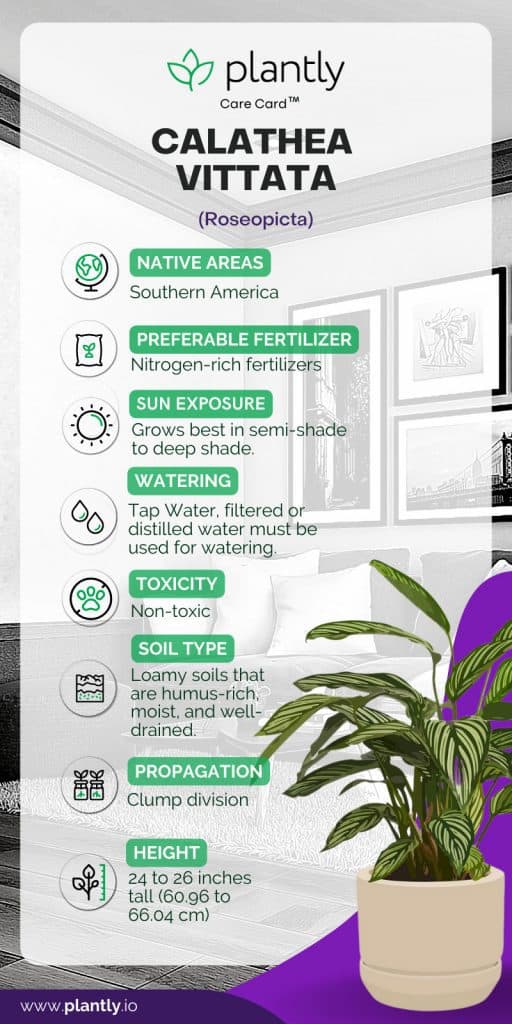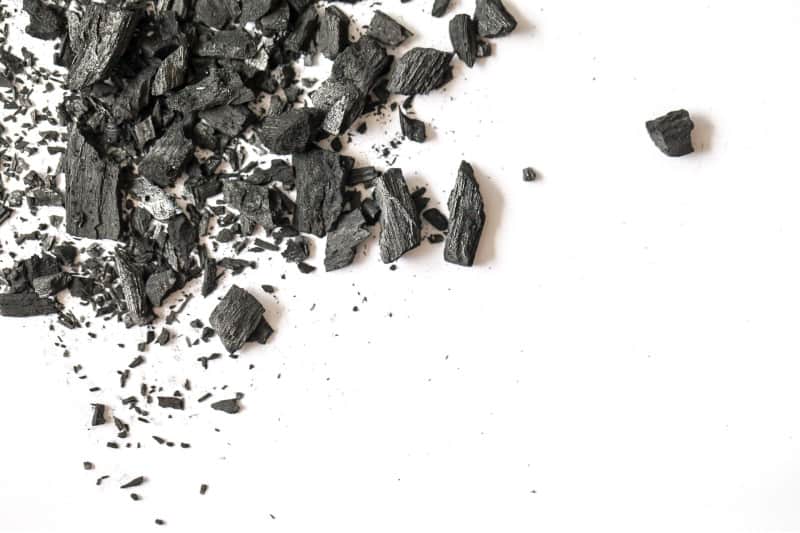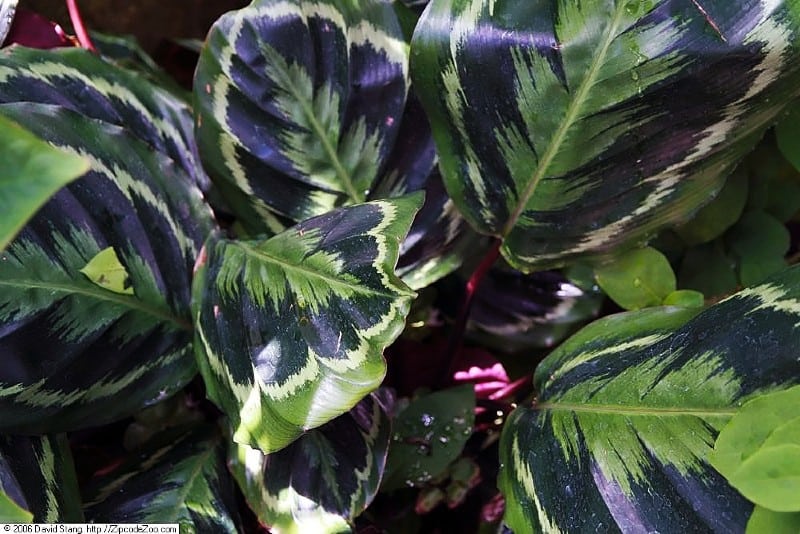No products in the cart.
Table of Contents
Did you know that this plant is rare and difficult to get by? Some of the characteristics of this plant include stunning arrangements on the leaves. It will even make you wonder if it’s a plant or an artwork.
They have dark green leaves that are delectable. And beneath those leaves is a lovely burgundy-purple that genuinely stands out. The blossoms have a light cream color to them. This indoor plant is smaller than the others of its kind, growing to a height of 24-26 inches.
If you want to add this to your collection, find out more below. The table below is the basic information about the Calathea vittata. This information briefly introduces the basic care and maintenance for this calathea.

Calathea Vittata Plant Care Basics

The Calathea vittata should be given appropriate care. Providing the plant with an excellent growing condition is vital for the plant’s growth. The following are the care tips on how to take care of the calathea vittata properly.
Best Potting Mix
The soil requirement of the Calathea vittata is a well-draining soil type with peat and perlite for aeration and for easy draining of water. The soil where this calathea is planted should be warm and moist at all times.
The soil mix of the plant can be added with orchid bark and charcoal to make the plant healthy and attractive as it grows. A well draining soil is one of the vital elements in your Calathea Vittata plant care.


The soil of the plant should have good drainage holes in order for the excess water to drain quickly.
Watering Needs
A medium amount of water is what this prayer plant requires. It should be watered regularly but not overwater or underwater. Like the rest of the calatheas, the plant does not enjoy an exceeding or insufficient amount of water.
The prayer plant should be watered when it is needed. Before watering the plant, check the dampness of the topsoil. You can use your finger to insert on the topsoil.
Rain or distilled water is the advisable type of water for the houseplant. They’re generally free of chemicals that can potentially harm the plant.
Lighting Condition
Calathea vittata needs medium to bright indirect light. This light condition is preferred by most calatheas. Filtered sunlight is also preferable. Medium to bright indirect light can give the best condition for the plant to thrive. Low light is not a recommended light condition.
It is important to note that direct sunlight can cause the plant to scorch its leaves. Also, this plant is sensitive to high sun exposure and sudden change in temperature. It is critical to keep an eye on your calathea plant so it doesn’t suffer from strong light intensities.
Temperature & Humidity
The temperature requirement of the calathea is the same as that of the tropical climate. Calathea is known to be a tropical plant. This means that it could best thrive and tolerate conditions where the temperature is at 15-30oC (59-86oF).
Temperatures below and above the range can stress the calathea. If the temperature goes too high, consider placing the calathea in a temporary place where the temperature is warmer.
It’s best to place the plant outdoors during the summer and spring seasons. On the other hand, it’s best to place it indoors during the winter and fall seasons. Watch for a sudden increase or decrease in temperature. This gives you a hint at when is the right time to place the calathea away from its permanent place.
High humidity is required by calathea. This is understandable since the plant is tropical in nature. The higher the humidity level, the better the condition you’re giving on the plant. Ít encourages the plant to grow well and to thrive easily, making it easier for propagation for the next year or two.
When planted in a place with a medium level of humidity, the plant can still survive and thrive. However, there will be an enormous difference compared to the tropical plants that grow well with a higher humidity level. Low humidity is not ideal for this plant.
To ensure consistent and higher humidity levels, you can use any available techniques and equipment present in your home or buy in the nearest garden store. You may use a humidifier, a container with a pebble tray filled with water, and a mist.
A Pebble tray filled with water can make sure that the required humidity level of the plant has been maintained. At the same time, the pebble tray technique could help the plant retain dampness if the gardener failed to water the plant at the right time.
It is important to remember that the bathroom and the kitchen room have a consistent, higher humidity level that allows the plant to thrive well. You may consider placing your calathea plant there.
Fertilizer
The requirement of the calathea is a fertilizer rich in nitrogen. This will help the plant grow faster and develop dense foliage.
I highly prefer organic fertilizers for calathea because it has no adverse effects on the plant. In addition to that, organic fertilizers help improve the soil’s structure and texture.
Spring and summer seasons are the preferable seasons where you could give apply fertilizer. These two seasons are known as the growing seasons for the houseplant.
During fall and winter, you must not give the plant fertilizer. The calathea is usually dormant so nutrients aren’t much needed. Excessive fertilizer application to the calathea can lead to salt build-up on the soil. It can increase the soil’s acidity leading to the unavailability of nutrients for plant absorption.
Propagation
Calathea vittata propagation prefers to be done in March, just before the growing season starts. Another crucial aspect of propagation is that division rather than cutting is the most effective method.
Here’s how you will do it:
- Keep in mind the plant you wish to propagate should be clean and fresh before you start.
- Separate the stems into as many plants as you want them to be. Each branch will produce new growth.
- Transfer each one to separate pots.
- After you’ve re-potted the plants, you can water them. Beware not to drown your plants because they are prone to rotting.
- Wait patiently and notice the new plants sprout.
Growth Zone
The calathea is a fast-growing plant and can easily mature when properly taken care of. The plant can grow up to 24 to 26 inches tall. USDA Hardiness Zones 9 to 11 are suited for this plant.
Potting
Re-potting the plant could be best done if the plant is starting to outgrow its environment. Another indication that the plant needs to be re-potted is when the roots are starting to get out of the pot.
When repotting the plant, it is important to transfer it into a slightly bigger pot than the former; allowing the plant to grow once again.
Calathea Vittata Plant Varieties and Similarities
There are approximately 200 species of calatheas plants. One of which is the calatheas. Here are some of the examples of colorful calatheas species or varieties that have a bit similarity to the calatheas:
Round-Leaf Calathea

This variety has 8-12 inch wide, leathery leaves with creamy and light-green stripes. It prefers humid conditions and well-draining soil. Keep it under partial shade.
Rattlesnake Plant

Rattlesnake calathea features long and narrow, light-green leaves with edges in dark green marks. Place the plant in bright filtered light and use rich, well-draining soil.
Furry Feather
Also known as velvet calathea, it has lance-shaped green foliage with velvety purple undersides on long burgundy stems. It is tolerant to lower light conditions.
Corona

Corona or Rose painted calathea has large glossy foliage with bright green to creamy patterns. It thrives in well-draining soil. Protect the plant from cold drafts.
Jungle Velvet

It grows in lance-shaped, velvety dark green leaves with light green patterns. Grow the plant in high humid conditions or use a humidifier.
Calathea Vittata Plant Diseases & Pests
Pests and fungus gnats are two of the common problems that emerge in calatheas. These gnats resemble mosquitos, but they are far more harmful to your plant. They may eat its leaves and stem and usually congregate in swarms. They’re attracted to your calathea because of the moist soil.
Cover the top of your pot with an inch or so of dry ground. The roots’ ends will be in a humid environment, and the dry dirt on the surface will keep the gnats away.
Frequently Asked Questions
Calathea is an air-purifying houseplant. It’s a beautiful eye-catcher in any interior while contributing to a better and healthier indoor environment. Calatheas are recommended as a plant to keep in the bedroom because of their ventilating characteristics and humidifying abilities. It aids in getting a better night’s sleep and wakes you up feeling invigorated!
Vittata leaves are lustrous dark green with white pinstripes. This Calathea’s variegation made it rare collectible houseplants that also look wonderful in a pot. Calathea vittata’s exquisite white banding is particularly remarkable, as it appears to be hand-painted.
Calathea vittata is a pet-friendly houseplant. Prayer plants are often known because their leaves fold up at night; they are non-toxic to cats and dogs and offer a splash of color to any room.
Buy your Calathea Vittata at Plantly! They offer this delicate plant without any blemish and can ensure the plant’s condition. Message us now!
Whether you want to buy, sell or simply reach out to other plant enthusiasts, Plantly is the right place to be!


